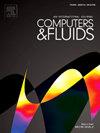Development of new wall functions for RANS model in superhydrophobic surface based on CFD and data-driven uncertainty quantification
IF 3
3区 工程技术
Q3 COMPUTER SCIENCE, INTERDISCIPLINARY APPLICATIONS
引用次数: 0
Abstract
This study investigates turbulent channel flow over superhydrophobic surfaces using direct numerical simulation and k- turbulence model with a newly developed wall function. A surrogate model, constructed using Gaussian Process Regression, predicts slip velocity and shifted velocity based on SHS texture parameters, specifically texture spacing and solid fraction. Direct numerical simulation conducted at a friction Reynolds number of , reveal strong linear relationships between slip velocity and shifted velocity . The surrogate model is validated against existing direct numerical simulation data, demonstrating high accuracy with an R-squared value of 0.957 and minimal prediction error. This surrogate model to predict the slip velocity is incorporated into a modified wall function for the k- turbulence model, which is implemented and tested using the open source software OpenFOAM. The proposed wall function yields results that align well with direct numerical simulation predictions in the near wall region, while some discrepancies occur in the log-layer due to the fundamental differences between direct numerical simulation and Reynolds-averaged Navier-Stokes methodologies. Despite these differences, the new wall function provides an efficient approach for simulating superhydrophobic surface channel flows using Reynolds-averaged Navier-Stokes models, reducing computational costs while maintaining acceptable accuracy. This research establishes a robust framework for integrating superhydrophobic surface effects into turbulence modelling, enhancing predictive capabilities for complex engineering applications.
基于CFD和数据驱动不确定性量化的超疏水表面RANS模型新壁函数的开发
本文采用直接数值模拟和k-ε湍流模型研究了超疏水表面上的湍流通道流动。利用高斯过程回归构建代理模型,基于SHS纹理参数,特别是纹理间距和固体分数,预测滑移速度和位移速度。在摩擦雷诺数Reτ=180时进行的直接数值模拟表明,滑移速度和位移速度之间存在很强的线性关系。利用已有的直接数值模拟数据对代理模型进行了验证,结果表明代理模型具有较高的预测精度,r平方值为0.957,预测误差最小。该预测滑移速度的替代模型被纳入k-ε湍流模型的修正壁面函数中,并使用开源软件OpenFOAM进行了实现和测试。所提出的壁面函数得到的结果与近壁面区域的直接数值模拟预测非常吻合,而由于直接数值模拟和reynolds -average Navier-Stokes方法之间的根本差异,在测井层中出现了一些差异。尽管存在这些差异,但新的壁函数为使用reynolds -average Navier-Stokes模型模拟超疏水表面通道流动提供了有效的方法,在保持可接受的精度的同时降低了计算成本。这项研究为将超疏水表面效应整合到湍流模型中建立了一个强大的框架,增强了复杂工程应用的预测能力。
本文章由计算机程序翻译,如有差异,请以英文原文为准。
求助全文
约1分钟内获得全文
求助全文
来源期刊

Computers & Fluids
物理-计算机:跨学科应用
CiteScore
5.30
自引率
7.10%
发文量
242
审稿时长
10.8 months
期刊介绍:
Computers & Fluids is multidisciplinary. The term ''fluid'' is interpreted in the broadest sense. Hydro- and aerodynamics, high-speed and physical gas dynamics, turbulence and flow stability, multiphase flow, rheology, tribology and fluid-structure interaction are all of interest, provided that computer technique plays a significant role in the associated studies or design methodology.
 求助内容:
求助内容: 应助结果提醒方式:
应助结果提醒方式:


